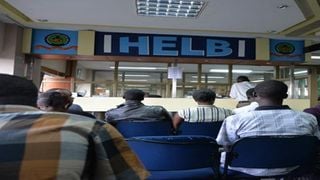
The Higher Education Loans Board offices in Nairobi. Key advantages of the Odemmusta app lie in its ability to discriminate students according to their levels of need, time saved in applying and receiving feedback on ‘loanable status’.
| File | Nation Media GroupWeekly Review
Premium
Inside the game-changing Odemmusta HELB app
One day, during his undergraduate studies at the Egerton University’s Njoro Campus, Stephen Odebero – a third-year student – skipped lectures because he was too weak to wake up and walk to the lecture hall. He had gone for three days without a meal.
His roommate and classmate, Bernard Muronga, returned to the hostel at 11am to find Odebero languishing in bed – scrawny and faint. Dr Muronga, who is today a lecturer at the University of Amoud in Somaliland, recalls quickly summoning “comrades” to get some food for his friend. Some bread and tea was arranged from the next room and Odebero began to regain his strength.
This single incident in 1994 inspired Odebero to reflect on other needy cases, especially of college students too hungry to learn. Although tuition expenses were catered for by the government during his time, a scholarship or private financial boost was required to take care of indirect expenses such as purchase of books, printing of reading material, notes from lecturers and research work, as well as living expenses and transport.
Disturbed by his personal struggle to successfully complete college education, Odebero was keen to find a way to help needy students through loans or scholarships to cover indirect private costs.
Several decades later, his dream has come to fruition – thanks to Masinde Muliro University of Science and Technology’s (MMUST) invention of an online computer application for equitable targeting of needy students in the disbursement of Higher Education Loans Board (Helb) loans.
Prof Odebero, a seasoned researcher and the Director of Postgraduate Studies at MMUST, is the brains behind the innovation, alongside co-innovator Mr Hesbon Amwayi. The tool is an offshoot of Prof Odebero’s PhD thesis on “equity in Helb loan financing in Kenya in relation to demand, supply and effectiveness in loan recovery”. It took him over 15 years to crack the innovation.
“As a result of this study, it was established that the means testing instrument used by Helb was not effective in targeting the needy university students and more particularly, it could not effectively pick out students according to their different levels of need,” he says of his post-graduate thesis, which was supervised by Prof Joseph Bosire and Prof Anthony Kiplangat Sang of Egerton University.
The latest innovation – born out of a scientific study – on identification of Helb beneficiaries is the first of its kind in Kenya and in the larger eastern Africa region. Other models adopted so far have not been based on scientific inquiry as factors influencing demand for students’ loans on one hand and supply on the other.
The MMUST product departs from the way Helb has been identifying the needy in several ways. First, an applicant for a Helb loan does not have to obtain and fill forms manually; the application is done online. Secondly, the innovation uses the app to instantaneously process the information provided by applicants; as soon as one finishes providing information, their level of need is determined.
This prepares applicants early enough to look for additional funds in the event that their applications are not successful. The tool is patented by the Kenya Industrial Property Institute (KIPI) as “Odemmusta” to MMUST, Prof Odebero and Amwayi.
The import of this is that anyone using the app must partner with MMUST and the two researchers from the Kakamega County-based institution. Key advantages of the Odemmusta app lie in its ability to effectively discriminate students according to their levels of need, time saved in applying and receiving feedback on “loanable status”, and cost-effectiveness as it is done online.
The app has inbuilt mechanisms to detect cheating. It uses past information such as personal identification numbers used in primary and high schools to link the applicants’ past status to the present situation which, Odebero and Amwayi point out, reduces chances of cheating. Being an online app, the entire process reduces chances of human interference in loan allocation. This, according to Odebero’s thesis, was found to be a major impediment in the issuance of student loans, with HELB staff accused of influencing loan allocation to recipients.
In a comment on MMUST’s official website, Vice-Chancellor Prof Solomon Shibairo observes that the innovation “actualises the grave responsibility of higher institutions as catalysts for socio-economic development through the creation of new knowledge, research and commercialisation of outputs emanating from these initiatives”. He further urges scholars and researchers to forge powerful collaborations with the business sector to translate research findings into industries to create wealth and jobs.
“This is in tandem with our mandate as a University of Science, Technology, and Innovation. We are keen to foster research output that creates innovations that contribute to socio-economic development,” says Prof Shibairo.
In testing the app’s efficacy, Prof Odebero explains that he conducted multiple regression analyses for the determinants of Helb loan supply. “A comparison of Helb loan allocations between the top and bottom quintile allocations showed that those in the top quintile tended to receive more loans than what was deserved, however, those in lower quintiles got a less than what they merited. If this model is used, this problem will be fixed.”
His co-innovator, Amwayi, offers assurance on the security of the app with regards to storage of and access to information submitted by users. The app, he explains, has a two-factor verification that adds an extra layer of security to the user’s account in case the password is stolen. Further, a Unique Personal Identifier number is linked to the Nemis to countercheck the authenticity of the information provided.
Previous studies have shown Helb loan allocation to needy students to be inequitable, factors that persuaded him and Amwayi to come up with an invention that bridges this gap “by enhancing the means of testing and targeting of the needy, apart from improving on the effectiveness in the loan application and disbursement process”.
The MMUST researchers believe this will be achieved when the App is in-built into the higher education financing model recently proposed by the presidential working party “so that we partner to give students a better and efficient means to apply and receive loans”. With his innovation, Prof Odebero is optmistic that fewer students will experience similar financial hardships as those that nearly forced him out of college.





